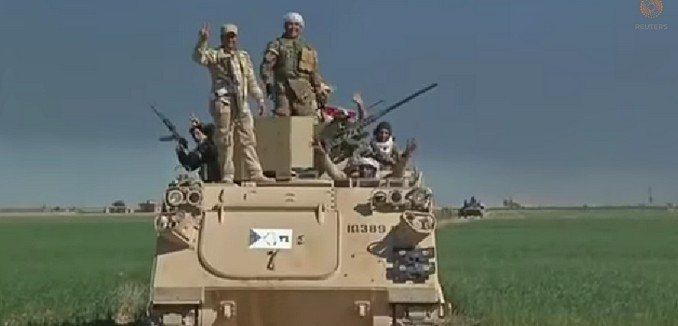Iraqi forces, substantially bolstered by Iranian-backed Shiite militias, launched an offensive last week to capture the Iraqi city of Tikrit from the Islamic State of Iraq and Syria (ISIS). Tikrit is a predominantly Sunni city and the hometown of former Iraqi President Saddam Hussein. It is reported that 30,000 fighters are taking part in the offensive, of whom two-thirds are Shiite militiamen and approximately 700-1,000 are Sunni tribal fighters. The New York Times reports that Iran’s Islamic Revolutionary Guard Corps (IRGC) has advisers and troops on the ground and is providing artillery, rocket launchers, and surveillance drones.
The Iraqi government did not ask for American air support for the offensive, according to the Associated Press, which has created fear of more Iranian influence and sectarian tensions. “This is the most overt conduct of Iranian support… Frankly, it will only be a problem if it results in sectarianism,” said Chairman of the Joint Chiefs of Staff Martin Dempsey in front of the Senate Armed Services Committee on Tuesday. However, Ali Khedery, a special assistant to five U.S. ambassadors to Iraq between 2003 and 2009, said that the “fundamental identity” of the Shiite militias is “built around a sectarian narrative rather than loyalty to the state.” Secretary of Defense Ashton Carter said before a House Appropriations defense subcommittee on Wednesday that “sectarianism is one of the things that concerns me very much. And of course, it’s the root of the Iranian presence in Iraq.” Iran analyst Karim Sadjadpour of the Carnegie Endowment for International Peace calls Iran “both the fire brigade and the arsonist.”
The Iranians and Iran-backed Shiite militias are led by Qassem Suleimani, the commander of the IRGC’s external arm, the Quds Force. Suleimani is a U.S.-designated terrorist who has been said to be responsible for up to 20 percent of American casualties during the Iraq War. Suleimani has been seen in and around Tikrit. Christopher Harmer, an analyst at the Institute for the Study of War, referred to Suleimani as “a more stately version of Osama bin Laden” and expressed concern of U.S. de facto cooperation with him.
It is feared that the Shiite militias will carry out revenge for ISIS’ massacre of over 1,000 predominantly Shiite fighters outside of Tikrit when they captured the city last June. Iraqi Prime Minister Haider al-Abadi has said that “in this battle, there is no neutral party.” The Washington Post’s editorial board expressed alarm last week that the U.S. is “allowing Iran to take another step toward…[a] malevolent hegemony.”
The Iranian involvement in the assault on ISIS in Tikrit is the latest engagement that prompted The New York Times last week to conclude that Iranian involvement in Iraq is United States government policy.
[Photo: Reuters / YouTube ]




